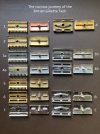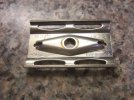- Messages
- 15,913
- Location
- Halifax, Republic of Yorkshire

I have posted a similar picture before in one of the many Gillette Tech mega-threads, but decided to make up a fresh one and re-arrange the models to show a developmental timeline but also show certainly a couple of side roads.
Straight into it ...
Building Baselines ...
1 Gillette New (USA) - Baseline New-type with long slot and ridge in the baseplate to accommodate the long bar
2 Gillette New (GB) - British New-type following the same material pattern
A Gillette Tech (USA) - Baseline pre-WW2 Tech ... long slot and diamond budge to accommodate and triangular drain holes
B Gillette Tech (USA) - Baseline post-WW2 Tech (1951 first date coded baseplate) ... still the long slot and same diamond bulge, but lozenge drain holes
Mighty-morphing Metal Magic?
3a Gillette New (GB) - Long-slotted New-type, but notice the slight indentation around the post to permit the handle to nip up?
4a Gillette Tech (GB) - Raised flat-bottom New-type where the raised part accommodates the bar, but notice that indentation has been removed?
3b Gillette Tech (GB) - Long-slotted Tech of the same material pattern as 3a
4b Gillette Tech (GB) - Known as the Hybrid Tech, notice the twin pins have become much shorter
Definitive Articles!
7 Gillette Tech (GB) - Flat-bottom Tech, popular throughout the 1940s - notice the diamond stamp and Made in England is on the upper half of the baseplate (as per 3b) which is the "usual" place for the Tech versus the lower half of the baseplace for the New-type (see 3a & 5)
B Gillette Tech (GB) - Diamond base Tech which replaced the flat-bottom Tech in the 1950s following material pattern of the American counterpart, but notice the shorter twin pins (seen in 4a>4b transition, 5, 6 & 7)
Odd One Out?
6 Gillette Tech (GB) - Flat-bottom Tech, but notice the diamond stamp and the Made in England is on the lower half of the baseplate as per the New-type and unlike the "usual" standard for the British flat-bottom Tech? I have placed this next to the post-WW2 American model as there is a detail which you can't see - on the side of the comb, there is a ridge on the British Tech (6) same as the later models (B & C) but not found on other British Techs of the 1940s. The razor does bear all the hallmarks of an earlier design possibility and are often found as "Service Sets" ... maybe consider this one a British-American Hybrid?
... and yes, I know. I know! The American post-WW2 Tech in position B is upside down. I'd like to say that was deliberate as some kind of mirror of the pre-WW2 in position A, but it was a mistake. No, I'm not going to get them all out again to take a corrected picture. I have tried flipping it around in software but it looks odd, so I'm going to stick to the mirror proposition and call it deliberate.
Summary?
American design stuck with a diamond bulge on the baseplate to accommodate the long-bar on the top cap and kept to that design from the off through the remainder of the 1930s, the 1940s and the 1950s where the model gained a slightly smaller handle.
British design went all over the place! Yep! All over the place ... but we can see it took its cues from the New-type, so as to usher in a development, if not cross-over of the New > Tech epoch. What we can see is that the baseline long-bar was trimmed not once, but twice to the short twin-pin design and that any kind of buldge, ridge or raised bottom simply flattened and cut out into twin-slots to accommodate.
That ... that, is arguably a design taken to its conclusion. Like when Steve Jobs (famously?) dropped the iPod prototype into a glass of water and noticed bubbles - he called for a redesign since the bubbles meant empty space, which meant the design had not been perfected.
Whatever!
All of these are fantastic shavers, each with an individual character that its fans will argue makes it the best.
You can check out the blade gaps thread (see: https://www.theshavingroom.co.uk/community/threads/interesting-tech-vid.57300/#post-893030) and the head weights thread (see: https://www.theshavingroom.co.uk/community/threads/gillette-tech-head-weights.54156/) to look for any actual material differences, but for me, the pre-WW2 Tech (USA) and the Hybrid Tech (GB) remain a couple of favourites, while the British-American Hybrid (in position 6) makes for a lovely piece of curio.
What is your favourite?


